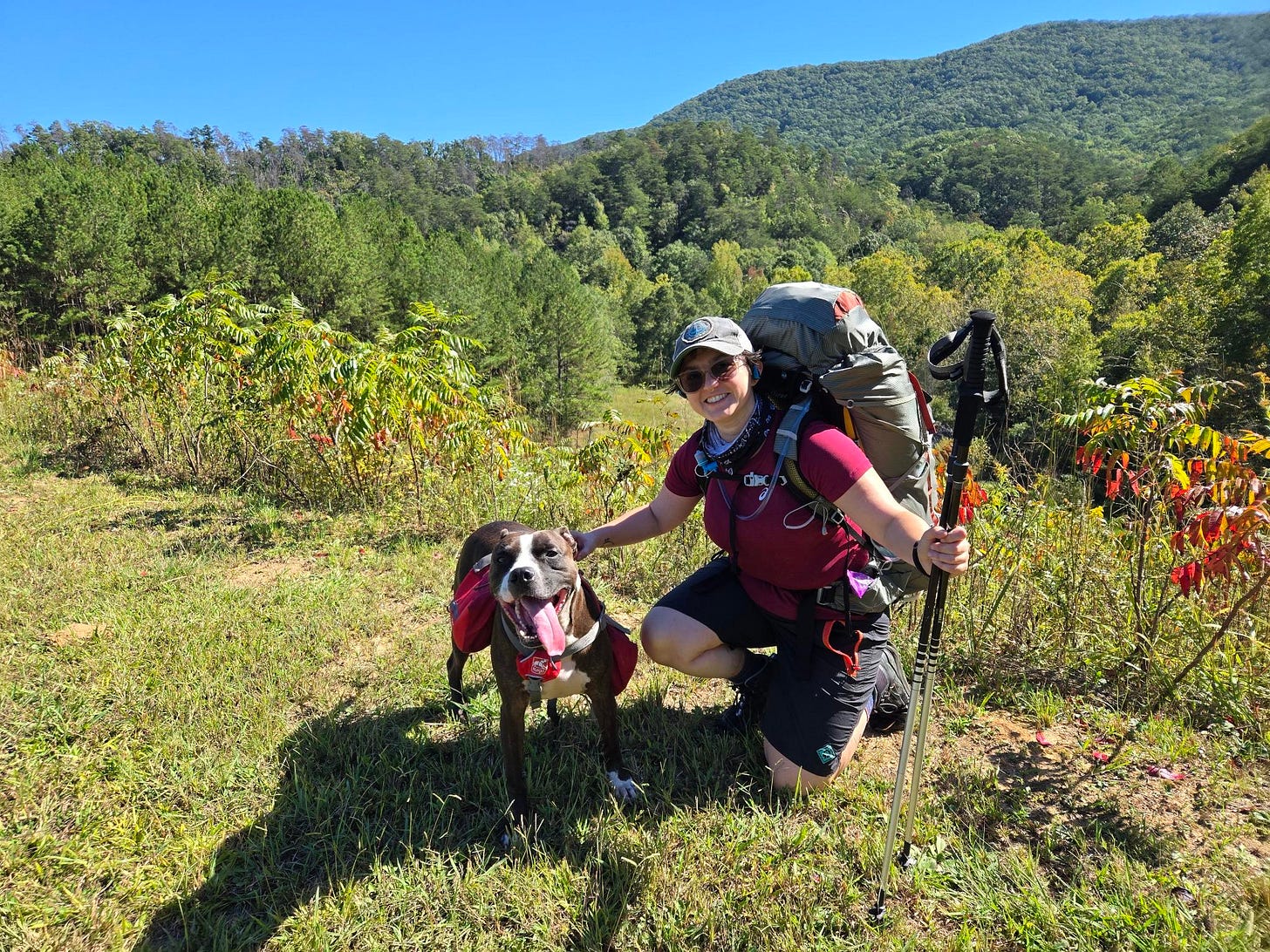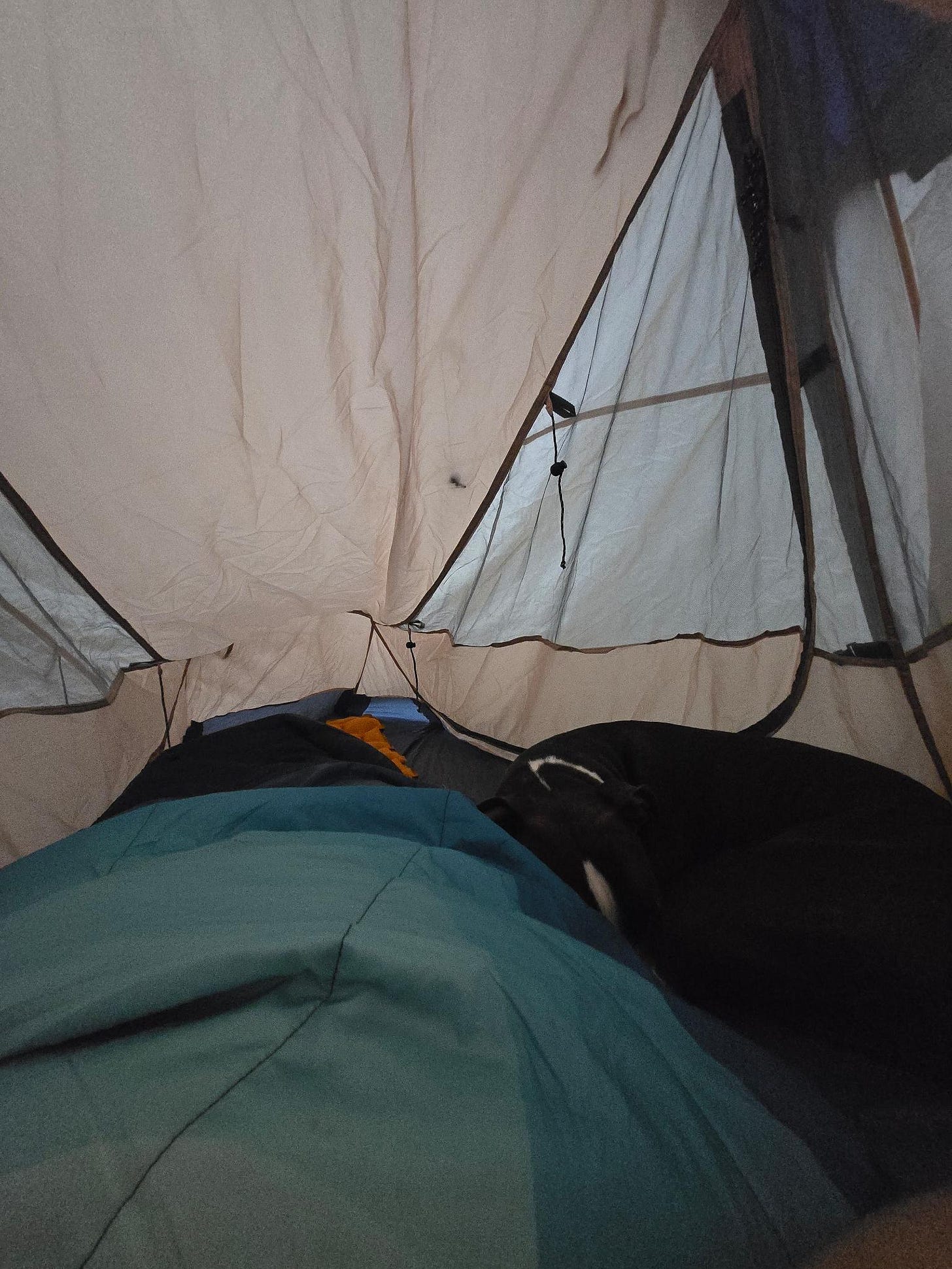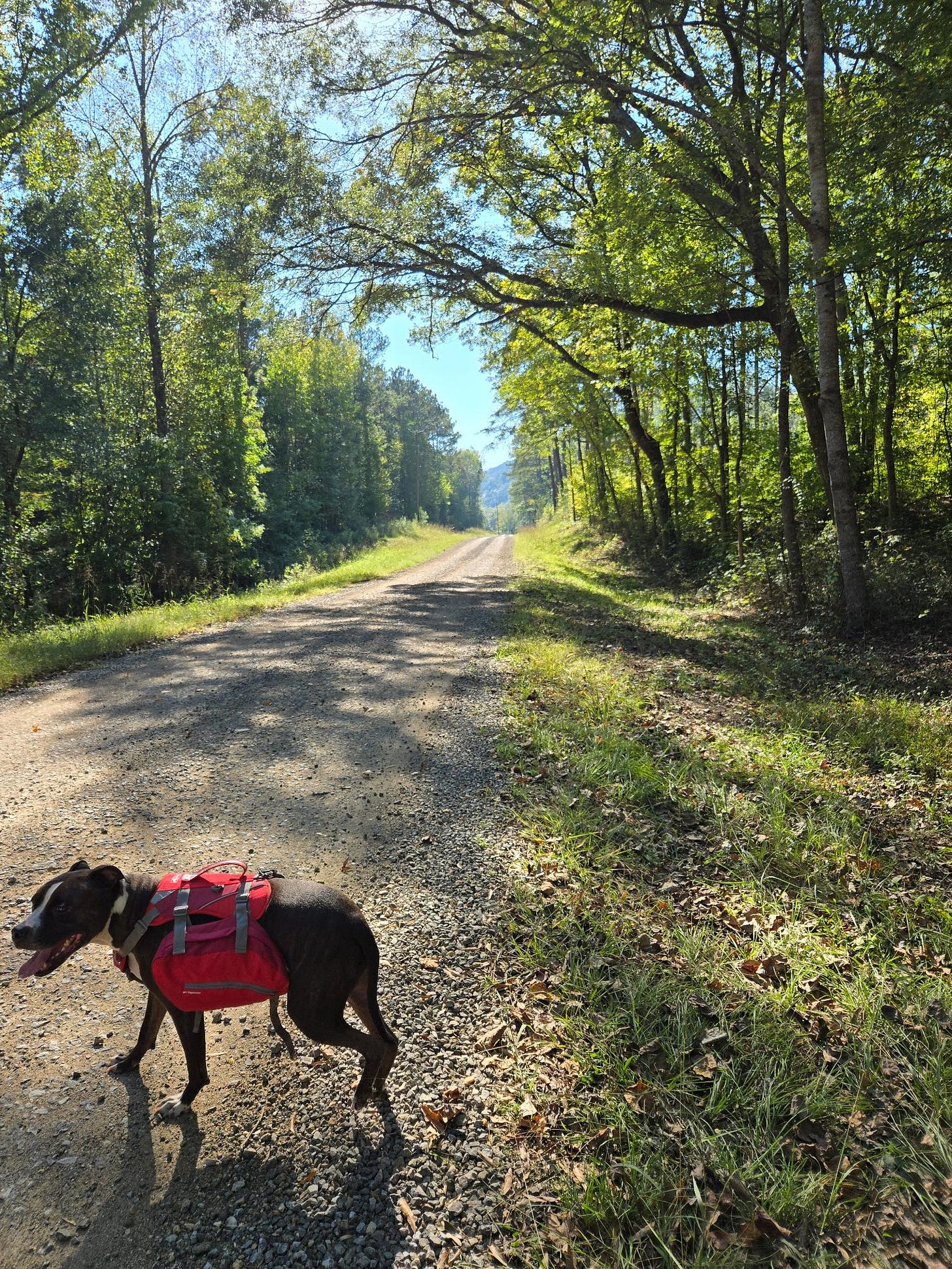I took my shelter pitbull backpacking: Here's what I learned about hiking with a dog
I took my 5-year-old pitbull I rescued from the animal shelter on a backpacking trip on the Pinhoti Trail. Here's what I learned and what I need to tweak before our next trip.
I made the bold decision to take my 5-year-old pitbull I rescued from the animal shelter on a backpacking trip this month. Overall, I’d say the trip went very well, but I did learn some important lessons about backpacking with a dog.
In this article, I’m going to introduce you to myself and my dog, Boo, and our collective backpacking experience.
First things first, let’s talk about my backpacking experience:
I entered the backpacking community by way of the trail ultramarathon community. It turns out that running distances that takes literally all day and walking all day with a heavy backpack tends to attract similar types of people.
Just like I thought ultrarunning was something for other, more elite and more ambitious people, I also believed that backpacking required taking 6 months off work to do “the correct way.”
Turns out that’s not true. You’ll find a lot more section hikers than thru-hikers along the Appalachian Trail. While thru-hiking sounds fun, most of my current backpacking buddies have never been thru-hikers. They are humble section hikers just like me. Whether you’re walking the whole trail on one trip or taking it day by day, you can still call yourself a “real” backpacker.
I’ve only backpacked about 200ish miles of the Appalachian Trail and Pinhoti Trail, so I’m still in that weird space between beginner and intermediate backpacker. I know enough to avoid some of the common pitfalls of backpacking, but I don’t feel like I have enough experience to call myself an “experienced” backpacker.
There’s so much to learn about backpacking and virtually a hundred ways to make hiking and living in the woods work for you. You may be a shelter-only camper, a tent-only camper or you may opt for something more unconventional like hammock camping or tarp camping.
I prefer tent camping. I’ve camped in shelters only, but I really only like this method if I know it’s not going to be crowded on the trail. I’ve been both the only person at a shelter and one of the dozen hikers who couldn’t fit in the 12-person shelter. Traffic on the trail will vary, so think about the kind of camp experience you want when choosing your preferred type of nighttime shelter.
For this trip with my dog, I opted for the tent. It didn’t matter who else would be at the shelter or campsite, I wanted to be sure me and my dog had a private spot to shelter together.
Not all hikers love dogs, so I wanted to be sure I had a place to put Boo where he felt safe and wouldn’t be distracted by anyone else at the campsite when it came to bedtime.
My dog’s outdoor experience:
Boo is a housepet. He is. I affectionately call him a “pillow pibble” (“pillow pitbull”) because he really just loves to cuddle, hunt for sticks in the yard and follow me around the garden.
I would not call my dog an athlete. He is active, as I take him for regular walks and he gets plenty of daily exercise. But he is not a distance runner like me. I’ve run short races with him and taken him with me on long runs. He usually only runs a max of about 10 miles with me. I was a little nervous about his endurance going into this hike, but I also knew he was capable of running 10 miles with me.
Unlike running, we would be taking regular breaks for snacks and lunch during the hike, so it wouldn’t be constant toil on the trail. However, I know how time on your feet can wear on your body and mind, so I wanted to be mindful of Boo’s limitations.
This brings me to problem #1 - dogs and heat don’t always mix.
On two days of this three-day hike, Boo threw up in the afternoon. It happened both times during the heat of the day. It happened suddenly. We were hiking at a good pace one moment and Boo is throwing up the next. As soon as he puked, he was back to smiling and hiking with mama (me).
I chalk this issue up to the heat. It was quite warm on my hike. We were hiking on the Pinhoti Trail. During the day, temperatures reached 80 degrees. When it’s 80 degrees and you’re walking uphill in the sun on exposed trail, it’s hot.
Dogs cannot sweat to cool themselves off, so they have to depend on their breathing and releasing a small amount of heat through their paw pads to stay cool. While you may be nauseated while sweating bullets, at least you are sweating. Your dog cannot.
Boo showed no other gastrointestinal distress aside from this brief afternoon puke, so I blame the heat. If you’ve noticed your dog does this when it’s warm, I’d like to hear your hypothesis on what could be causing this, if it’s not heat.
In the future, I will be taking Boo on cooler weather hikes only. I think he’ll be happy and I will be less worried about him getting too hot on the trail.
Carry your weight
For this trip, Boo carried all of his food, clothes and camp items in his very own dog pack. I bought the Kurgo Big Baxter Dog Backpack on Amazon for the low price of $59.99.
This pack is not the highest quality available and is not from a well-known name brand of dog pack you may have already seen pooches sporting on the trail. I am on a budget, and this item seemed comparable to the more popular name-brands at a handsome price.
This pack was very adjustable and had plenty of room for our trip. Boo weighs about 70 pounds and has a big barrel chest, so I was worries it would be difficult to find a pack that fit, but I was happy with the level of adjustment and customization I could do to make this pack fit Boo the best.
It took a day of trial at home and a day on trail to figure out exactly how the pack should be adjusted, but we finally did achieve a good fit.
Kibble trouble
When packing and carrying your pet’s food, I would recommend getting some sort of packaging that’s more durable that a ziploc bag. Boo eats dry kibble, so that’s what I packed for his food on the trail.
By the end of Day 3, these kibble bags looked beat to hell. The bags looked like they had been carrying gravel, which is about the texture of dog kibble.
In the future, I’ll have to find a better way to secure the food together in a tighter package to prevent that friction or find a better way to store the food.
If you backpack with your dog, how do you package and store their food for the trail? This was one area where I didn’t expect to have any issues, but alas, my food storage bags definitely disappointed me.
Boo did get a very small spot of chafing in one of his “armpits.” I’m not sure if this chafing was from the pack or just from the movement of walking 32 miles over three days. Either way the chafing spot was small and didn’t seem to bother him. I’m still glad I chose to end our trip when we did so that chafing didn’t get worse.
As much personality as Boo has, he can’t talk, which really sucks when you’re asking your pet to do an extreme activity with you. Instead of talking, you have to learn how to pay attention to your dog’s behavior and monitor their reactions to know how they’re feeling on trail.
This aspect of backpacking with a dog is what made me most anxious. I wanted him to have fun and to love backpacking as much as I do. I certainly didn’t want to traumatize him on a trip and ruin the outdoors for him. Luckily, neither happened and I think he thoroughly enjoyed his time in the woods.
Consider water:
For this trip, I carried all of me and Boo’s water. I’ve seen setups where dogs carry their own water, but I did not opt for this on this trip. In the future, I will definitely be considering a dog-carried water setup for Boo.
On this trip, water was scarce. Drought conditions and already sparse water along the Pinhoti made for a few nerve-wracking miles where we seriously questioned if we would make it to a water source before sunset. We did find water, but having to make sure I gathered enough water for me and Boo on each section meant I had to carry a lot of water—sometimes up to three liters—in order for us both to stay hydrated.
Water is heavy. Very heavy. Consider water access, weight and your dog’s ability to carry water.
If you’ve backpacked with a dog, how did you handle the water issue? I’m also seeking to improve the water situation for future trips with Boo, so I welcome your advice or stories about works for you and your pup.
Thanks for reading this edition of Annalytical and learning more about my sweet rescue pittie, Boo.






